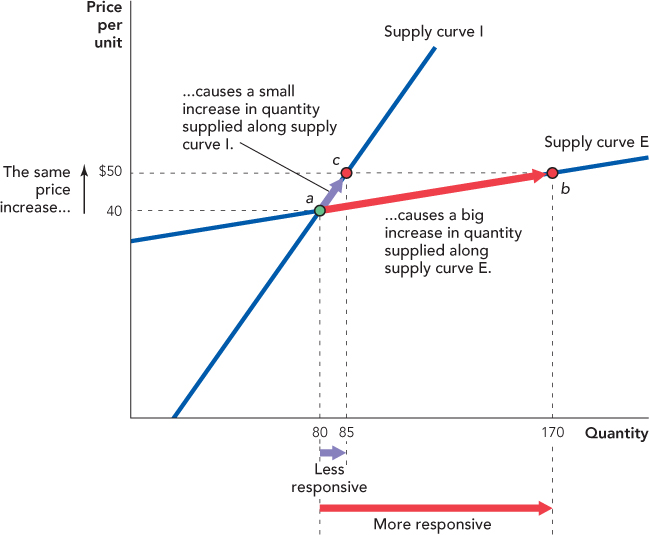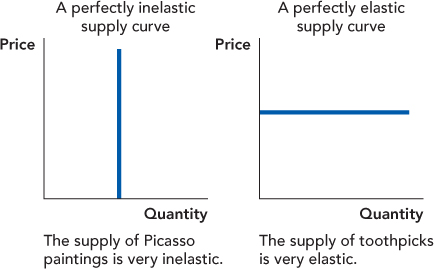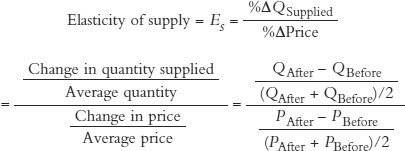The Elasticity of Supply
The elasticity of supply measures how responsive the quantity supplied is to a change in price.
When the price of a good like oil increases, suppliers will increase the quantity supplied, but by how much? Will the quantity supplied increase by a lot or by a little? The elasticity of supply measures how responsive the quantity supplied is to a change in price. To see the intuition, let’s take a look at Figure 5.6, which shows two different supply curves.
77
In Figure 5.6, when the price increases from $40 to $50, the quantity supplied increases from 80 to 85 along supply curve I but by the much larger amount from 80 to 170 along supply curve E. Since the quantity supplied is more responsive to a change in price, supply curve E is more elastic than supply curve I.

Determinants of the Elasticity of Supply
Which supply curve, supply curve I or supply curve E, do you think would better represent the supply curve for oil? Even large increases in the price of oil will not increase the quantity of oil supplied by very much because it’s not easy to quickly increase the production of oil. Producing more oil requires time and a significant increase in the costs of exploration and drilling. Thus, the supply curve for oil is not very elastic (we could also say inelastic) and would be better represented by supply curve I.
The fundamental determinant of the elasticity of supply is how quickly per-unit costs increase with an increase in production. If increased production requires much higher per-unit costs, then supply will be less elastic—or inelastic. If production can increase without much increasing per-unit costs, then supply will be elastic.
78
It’s usually difficult to increase the supply of raw materials like oil, coal, and gold without increasing costs—remember from Chapter 3 that the higher the price, the deeper the mine—so the supply of raw materials is often inelastic. The supply of manufactured goods is usually more elastic since production can often be increased at similar costs per unit by building more factories. To fully understand the elasticity of supply, let’s consider two goods that represent polar cases of the elasticity of supply: Picasso paintings and toothpicks.
Picasso won’t be painting any more canvases no matter how high the price of his paintings rises so the supply of Picasso paintings is not at all elastic—perfectly inelastic would be a good working assumption.* A perfectly inelastic supply curve is a vertical line. We show an example in the left panel of Figure 5.7, which indicates that even a very large increase in price won’t increase the quantity supplied.

Toothpick manufacturers, however, can increase the supply of toothpicks without an increase in their costs per toothpick by cutting down just a few more trees and running them through the mill. Thus, a small increase in the price of toothpicks will generate a large increase in quantity supplied; that is, the supply of toothpicks will be very elastic—perfectly elastic would be a good working assumption. A perfectly elastic supply curve is flat, which indicates that even a tiny increase in price increases the quantity supplied by a very large amount. We show a perfectly elastic supply curve in the right panel of Figure 5.7.
It’s easy to expand the supply of toothpicks because even if the toothpick industry doubles in size, the increases in the demand for wood will be negligible, so the toothpick industry can expand without pushing up the price of its primary input, wood. But if the housing industry were to double in size, the demand for wood would increase dramatically, and since it takes time to plant and harvest new trees, the price of wood and thus the price of houses would increase in the short run. More generally, supply is more elastic when the industry can be expanded without causing a big increase in the demand for that industry’s inputs.

A closely related point is that the local supply of a good is much more elastic than the global supply. The supply of oil to the world is inelastic because world production won’t increase without a significant increase in the cost of production per barrel. But imagine that more people move to Austin, Texas, increasing the demand for oil in that city. It’s very easy to ship more oil to Austin from other parts of the United States so the supply of oil to Austin is well approximated by a perfectly elastic supply curve.
As with demand, supply tends to be more elastic in the long run than in the short run because in the long run, suppliers have more time to adjust. Suppliers can respond to an increase in the price of bicycles fairly quickly by running currently existing factories at higher capacity. Given more time, however, suppliers can increase output at lower cost by building new factories.
79
For some goods, it’s almost impossible to increase output much in the short run. The best Scotch whisky, for example, is aged in oak barrels for 10, 20, or even 30 years. If the price of such high-quality Scotch whisky increases today, it will be at least 10 years before supply can increase.
We summarize the primary factors that determine the elasticity of supply in Table 5.3.
TABLE 5.3 Primary Factors Determining the Elasticity of Supply
|
Less Elastic |
More Elastic |
|---|---|
|
Difficult to increase production at constant constant unit cost (e.g., some raw materials) |
Easy to increase production at unit cost (e.g., some manufactured goods) |
|
Large share of market for inputs |
Small share of market for inputs |
|
Global supply |
Local supply |
|
Short run |
Long run |
Calculating the Elasticity of Supply
The elasticity of supply is a measure of how responsive the quantity supplied is to a change in price. It is computed by

The elasticity of supply also has a precise definition. The elasticity of supply is the percentage change in the quantity supplied divided by the percentage change in price.
Examples:
 If the price of cocoa rises by 10% and the quantity supplied increases by 3%, then the elasticity of supply for cocoa is
If the price of cocoa rises by 10% and the quantity supplied increases by 3%, then the elasticity of supply for cocoa is  .
.
 If the price of coffee falls by 10% and the quantity supplied of coffee falls by 1.5%, then the elasticity of supply for coffee is
If the price of coffee falls by 10% and the quantity supplied of coffee falls by 1.5%, then the elasticity of supply for coffee is  .4
.4
Using the Midpoint Method to Calculate the Elasticity of Supply As with demand elasticities, it’s important to calculate percent changes for supply elasticities using the midpoint method. Here is the midpoint formula for the elasticity of supply.
